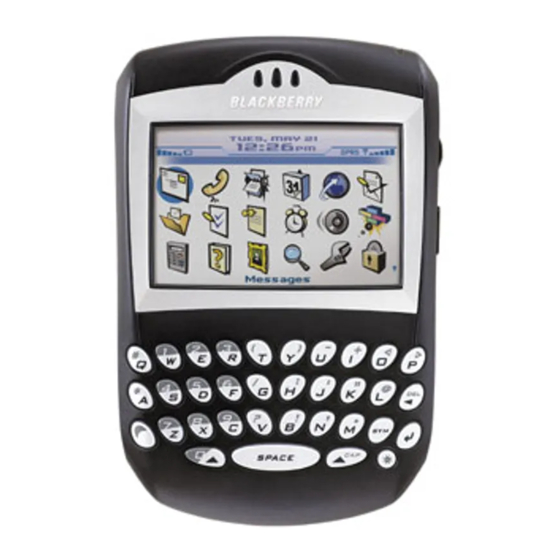Blackberry 7250 - MANUEL 4 Güvenlik ve Ürün Bilgileri - Sayfa 6
El bilgisayarları Blackberry 7250 - MANUEL 4 için çevrimiçi göz atın veya pdf Güvenlik ve Ürün Bilgileri indirin. Blackberry 7250 - MANUEL 4 10 sayfaları. Wireless handheld
Ayrıca Blackberry 7250 - MANUEL 4 için: Başlangıç Kılavuzu (13 sayfalar), Manuel (19 sayfalar), Manuel (12 sayfalar), Başlangıç Kılavuzu (27 sayfalar)

Safety and Product Information Booklet
Cleaning: Do not use liquid, aerosol cleaners, or solvents on or near the device or device accessory. Clean only with a
soft dry cloth. Disconnect any cables from the computer and unplug any charging accessories from the electrical outlet
before cleaning either the device or the charging accessory.
Compliance information
Exposure to radio frequency signals
The BlackBerry device radio is a low power radio transmitter and receiver. When the device radio is on, it receives and
also sends out RF signals. The device complies with FCC and Industry Canada (IC) guidelines respecting safety levels of
RF exposure for wireless devices, which in turn are consistent with the following safety standards previously set by
Canadian, U.S., and international standards bodies:
• ANSI/IEEE C95.1, 1999, IEEE Standard for Safety Levels with Respect to Human Exposure to Radio Frequency
Electromagnetic Fields, 3 kHz to 300 GHz
• National Council on Radiation Protection and Measurements (NCRP) Report 86, 1986, Biological Effects and
Exposure Criteria for Radio Frequency Electromagnetic Fields
• Health Canada, Safety Code 6, 1999, Limits of Human Exposure to Radio Frequency Electromagnetic Fields in the
Frequency Range from 3 kHz to 300 GHz
• International Commission on Non-Ionizing Radiation Protection (ICNIRP), 1998, Guidelines for limiting exposure to
time-varying electric, magnetic, and electromagnetic fields (up to 300 GHz)
To maintain compliance with FCC and IC RF exposure guidelines when carrying the device on your body, use only RIM-
supplied or approved accessories, or accessories that contain no metallic components and provide a separation distance
from the body of at least 15 mm (0.60 inches). Use of accessories that are not expressly approved by RIM might violate
FCC and IC RF exposure guidelines and might void any warranty applicable to the device. When carrying the device
while the device radio is on, use the specific RIM-approved holster that has been tested for compliance. For data
operation (when you do not use a RIM-approved, body-worn accessory and are not holding the device at the ear),
position the device at least 15 mm (0.60 inches) from the body.
Specific absorption rate data
THIS WIRELESS DEVICE MODEL MEETS GOVERNMENT REQUIREMENTS FOR EXPOSURE TO RADIO WAVES.
The BlackBerry device is a radio transmitter and receiver. It is designed and manufactured not to exceed the emission
limits for exposure to radio frequency (RF) energy set by the Federal Communications Commission (FCC) of the U.S.
Government and Industry Canada of the Canadian Government (IC). These limits are part of comprehensive guidelines
and establish permitted levels of RF energy for the general population. The guidelines are based on standards that were
developed by independent scientific organizations through periodic and thorough evaluation of scientific studies. The
standards include a substantial safety margin designed to assure the safety of all persons, regardless of age and health.
The exposure standard for wireless devices employs a unit of measurement known as the Specific Absorption Rate, or
SAR. The SAR limit set by the FCC/IC is 1.6W/kg*. Tests for SAR are conducted using standard operating positions
specified by the FCC/IC with the device transmitting at its highest certified power level in all tested frequency bands.
Although the SAR is determined at the highest certified power level, the actual SAR level of the device while operating
can be well below the maximum value. This is because the device is designed to operate at multiple power levels so as
to use only the power required to reach the network. In general, the closer you are to a wireless base station antenna,
the lower the power output.
Before a wireless device model is available for sale to the public, it must be tested and certified to the FCC and IC that
it does not exceed the limit established by the government-adopted requirement for safe exposure under the
recommendations of the International Commission on Non-Ionizing Radiation Protection (ICNIRP). The tests are
performed in positions and locations (for example, at the ear and worn on the body) as required by the FCC, IC and for
each model.
6
